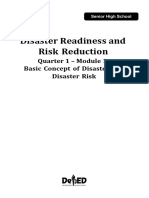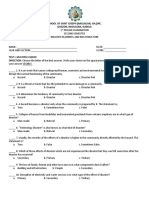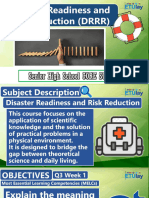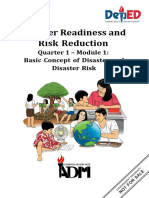0 ratings0% found this document useful (0 votes)
87 viewsSummative Test - Written Work #1
Summative Test - Written Work #1
Uploaded by
Joshua VicenteThis document contains a 15-item summative test on disaster readiness and risk reduction. The test examines concepts like plate tectonics, disaster mitigation, hazards, vulnerabilities, and factors that exacerbate or lessen disaster risk. It also contains a performance task that asks students to analyze COVID-19 risk factors in the Philippines by differentiating 3 factors (physical, psychological, socio-cultural, economic, political, or biological) and citing examples for each. Students will be graded using a rubric for their response.
Copyright:
© All Rights Reserved
Available Formats
Download as DOCX, PDF, TXT or read online from Scribd
Summative Test - Written Work #1
Summative Test - Written Work #1
Uploaded by
Joshua Vicente0 ratings0% found this document useful (0 votes)
87 views2 pagesThis document contains a 15-item summative test on disaster readiness and risk reduction. The test examines concepts like plate tectonics, disaster mitigation, hazards, vulnerabilities, and factors that exacerbate or lessen disaster risk. It also contains a performance task that asks students to analyze COVID-19 risk factors in the Philippines by differentiating 3 factors (physical, psychological, socio-cultural, economic, political, or biological) and citing examples for each. Students will be graded using a rubric for their response.
Original Title
DRR
Copyright
© © All Rights Reserved
Available Formats
DOCX, PDF, TXT or read online from Scribd
Share this document
Did you find this document useful?
Is this content inappropriate?
This document contains a 15-item summative test on disaster readiness and risk reduction. The test examines concepts like plate tectonics, disaster mitigation, hazards, vulnerabilities, and factors that exacerbate or lessen disaster risk. It also contains a performance task that asks students to analyze COVID-19 risk factors in the Philippines by differentiating 3 factors (physical, psychological, socio-cultural, economic, political, or biological) and citing examples for each. Students will be graded using a rubric for their response.
Copyright:
© All Rights Reserved
Available Formats
Download as DOCX, PDF, TXT or read online from Scribd
Download as docx, pdf, or txt
0 ratings0% found this document useful (0 votes)
87 views2 pagesSummative Test - Written Work #1
Summative Test - Written Work #1
Uploaded by
Joshua VicenteThis document contains a 15-item summative test on disaster readiness and risk reduction. The test examines concepts like plate tectonics, disaster mitigation, hazards, vulnerabilities, and factors that exacerbate or lessen disaster risk. It also contains a performance task that asks students to analyze COVID-19 risk factors in the Philippines by differentiating 3 factors (physical, psychological, socio-cultural, economic, political, or biological) and citing examples for each. Students will be graded using a rubric for their response.
Copyright:
© All Rights Reserved
Available Formats
Download as DOCX, PDF, TXT or read online from Scribd
Download as docx, pdf, or txt
You are on page 1of 2
Disaster Readiness and Risk Reduction Test 1
SUMMATIVE TEST – WRITTEN WORK #1
Directions: Select the best answer. Write your answers in CAPITAL LETTERS on the space before the number.
_____1. Which of the following most likely lead to mountain building, volcanism and ocean formation?
a. Atmospheric processes c. Human activities
b. Plate tectonics d. Biological accumulation
_____2. What refers to the lessening or limitation of adverse effects of hazards and related disasters?
a. Disaster Preparedness c. Disaster Rehabilitation
b. Disaster Mitigation d. Disaster Response
_____3. The possibility that something bad or unpleasant (such as injury or a loss) will happen is best defined as:
a. Risk b. Risk Factors c. Vulnerability d. Hazard
_____4. What refers to the knowledge and capabilities needed by institution and individual to anticipate and
respond to the impacts of hazards?
a. Disaster Preparedness c. Disaster Rehabilitation
b. Disaster Mitigation d. Disaster Response
_____5. This is known as Philippine Disaster Risk Reduction and Management Act of 2010.
a. RA 10112 b. RA 10121 c. RA 11012 d. RA 01121
_____6. Disaster Risk factors are variables that either aggravate or mitigate the effects of hazards, affecting the
degree or scope of a disaster. What factors would pertain to the availability of fire exits, the sturdiness of the
building, or the presence or absence of objects that can harm you or help you?
a. Socio-cultural b. Economic c. Physical d. Psychological
_____7. What factor would include income and the asset or liability of a community?
a. Political b. Economic c. Socio-cultural d. Biological
_____8. Disaster is frequently described as a result of various condition except ________.
a. exposure to hazard c. conditions of vulnerability at present
b. having enough physical and social capabilities d. insufficient capacity or measures to cope up
_____9. Which can frequently be prevented and anticipated?
a. Man-made hazards c. Disasters
b. Socio-cultural Hazard d Natural Hazard
_____10. How could the National Economic and Development Authority (NEDA) intervene after the event of
disasters and calamities?
a. Provide life preservation and meet the basic subsistence needs of affected population.
b. Warn the community from the negative effects of hazards.
c. Educate the people in the community to mitigate the potential impact of hazards.
d. Restore and improve facilities, livelihood and living conditions of affected communities.
_____11. It may be determined by aspects such as population density levels, remoteness of a settlement, the site
design and materials used for critical infrastructure and for housing. What type of vulnerability this refers to?
a. Physical b. Social c. Economic d. Environmental
_____12. What refers to the inability of people, organization and societies to withstand adverse impacts to hazards
due to characteristics inherent in social interactions, institutions and system of cultural values.
a. Physical b. Social c. Economic d. Environmental
_____13. What could be the expected hazard for a family living in a concrete house near the highway far from river
and mountain?
I. Fire due to faulty electrical wiring
II. Ground shaking due to earthquakes
III. Flashfloods due to heavy rainfall
IV. Pyroclastic flow
a. I, II and IV b. I and II only c. I, II and III d. All of the above
_____14. What refers to the process or phenomenon of organic origin conveyed by biological vectors/agents,
including exposure to pathogenic microorganisms, toxins and bioactive substances?
a. Biological hazard c. Hydrometeorological hazard
b. Geological hazard d. Man-made hazard
_____15. Ballistic projectiles, ground shaking, landslide, lava flow, liquefaction and tsunami are examples of:
a. Man-made hazard c. Biological hazard
b. Geological hazard d. Hydrometeorological hazard
SUMMATIVE TEST – PERFORMANCE TASK #1
Before doing this activity, search, listen or watch news and article from reliable sources regarding the
Covid-19 situation in our country. Your activity is to differentiate the risk factors underlying disaster from
the current covid-19 outbreak situation in our country. You can choose at least 3 from the risk factors
variable (Physical, Psychological, Socio-cultural, Economic, Political, Biological) and differentiate each factor
by citing concrete examples on how this virus outbreak aggravate or mitigate the effects of this pandemic
in our country. Use short coupon bond for your output. You will be graded by using the rubrics below:
You might also like
- Leeboy - Asphalt - Paver PF-161CDocument348 pagesLeeboy - Asphalt - Paver PF-161CjulianNo ratings yet
- DRRR - Quarter ExamDocument3 pagesDRRR - Quarter Exammycah hagadNo ratings yet
- Pre Test - Disaster Readiness and Risk ReductionDocument2 pagesPre Test - Disaster Readiness and Risk ReductionMaria Elaine Ramos67% (3)
- DRRR Q1 Summative Test 1Document3 pagesDRRR Q1 Summative Test 1MA. HAZEL TEOLOGO100% (2)
- Khaleel Basha Shaik, 00734394,1308-Bharat Safety Training Igc 2 - Report 3Document15 pagesKhaleel Basha Shaik, 00734394,1308-Bharat Safety Training Igc 2 - Report 3s khaleel basha100% (4)
- Prefinal DRRMDocument3 pagesPrefinal DRRMAnonymous elE1cg6100% (1)
- Summative Test - Written Work #1: Republic of The Philippines Department of EducationDocument2 pagesSummative Test - Written Work #1: Republic of The Philippines Department of EducationJoshua VicenteNo ratings yet
- 4th Quarter - DRRM LONG QUIZ 4Document4 pages4th Quarter - DRRM LONG QUIZ 4Gilbert ObingNo ratings yet
- 4th Prelim 2020Document14 pages4th Prelim 2020Mira VeranoNo ratings yet
- Disaster and Risk ExamDocument3 pagesDisaster and Risk ExamMichael AprongNo ratings yet
- DRRR TestDocument4 pagesDRRR TestJosui CarpioNo ratings yet
- DRRR Q1 WK7 40 CopiesDocument16 pagesDRRR Q1 WK7 40 CopiesRubilyn RamosNo ratings yet
- DRRR Q1 Module 7Document12 pagesDRRR Q1 Module 7Vien Mossiah BaniagaNo ratings yet
- DRRRDocument15 pagesDRRRCiejay QuebralNo ratings yet
- Summative Test in DRRRDocument3 pagesSummative Test in DRRRGericNo ratings yet
- DRRR ST3Document2 pagesDRRR ST3Alvin GultiaNo ratings yet
- Cor 11 3RD Quarter ExamDocument5 pagesCor 11 3RD Quarter ExamNazer M. LacaboNo ratings yet
- Midterm Assessment For 3RD Quarter2Document4 pagesMidterm Assessment For 3RD Quarter2Erumi ShidouNo ratings yet
- NAT DRRM Questionnaire Set1Document13 pagesNAT DRRM Questionnaire Set1Shirley RaborNo ratings yet
- AssessmentDocument19 pagesAssessmentMary Pauline SolivenNo ratings yet
- Post TestDocument4 pagesPost TestLeanne GomezNo ratings yet
- DRRR (Assessments)Document87 pagesDRRR (Assessments)Eugene Anthony GonzagaNo ratings yet
- DRRR - Module 7Document15 pagesDRRR - Module 7Junah SumalinogNo ratings yet
- Exam - DRRRDocument3 pagesExam - DRRRmycah hagadNo ratings yet
- Midterm Exam Gas 400Document3 pagesMidterm Exam Gas 400angeline marie orillaNo ratings yet
- Drr-Prelim FinalDocument2 pagesDrr-Prelim FinalJARYL PILLAZARNo ratings yet
- DRRM 11 Summative TestDocument2 pagesDRRM 11 Summative TestJessmer niadasNo ratings yet
- Finals DRRDocument4 pagesFinals DRRDefine Vlog100% (1)
- Basic-Concept-of DisasterDocument19 pagesBasic-Concept-of DisasterElijah Del RosarioNo ratings yet
- Summative Test in DRR1Document5 pagesSummative Test in DRR1jing100% (1)
- M1 Basic Concept of Disasters and Disaster RiskDocument60 pagesM1 Basic Concept of Disasters and Disaster Riskbanaomarkrhone17No ratings yet
- School of Saint Joseph (Naguilian, Isa.) Inc. Quezon, Naguilian, IsabelaDocument2 pagesSchool of Saint Joseph (Naguilian, Isa.) Inc. Quezon, Naguilian, IsabelaYvette Marie Yaneza NicolasNo ratings yet
- Diagnostic Test in Disaster Readiness and Risk Reduction.22-23Document4 pagesDiagnostic Test in Disaster Readiness and Risk Reduction.22-23Jeralyn Vallecer-AbelloNo ratings yet
- Post-Test StemDocument3 pagesPost-Test StemLeanne GomezNo ratings yet
- DRRR12 Q1.23Document5 pagesDRRR12 Q1.23Carmel BautistaNo ratings yet
- Encircle The Letter of The Correct AnswerDocument2 pagesEncircle The Letter of The Correct AnswerMary Jane BaniquedNo ratings yet
- DRRRM Midterm Exam 2nd SemDocument3 pagesDRRRM Midterm Exam 2nd SemRenier Dela Vega FloresNo ratings yet
- Pre-Post TestDocument6 pagesPre-Post TestLeanne GomezNo ratings yet
- DRRR G12Document6 pagesDRRR G12JERVIN JESALVANo ratings yet
- SHS-DRRR - MODULE 2 - Concept of Disaster RiskDocument20 pagesSHS-DRRR - MODULE 2 - Concept of Disaster Riskhahajr80No ratings yet
- DRRR Q1 Module 1Document20 pagesDRRR Q1 Module 1Forlorn SigfridrNo ratings yet
- DRRR ExamDocument4 pagesDRRR ExamShaira Bartido100% (1)
- Cor 11 4TH Summative TestDocument3 pagesCor 11 4TH Summative TestNazer M. LacaboNo ratings yet
- DRRR 1st Summ Exam PDF FreeDocument2 pagesDRRR 1st Summ Exam PDF FreeManuel Paulo AcogidoNo ratings yet
- DRRR22 Q3 W3 1Document16 pagesDRRR22 Q3 W3 1danchelamarie.gonzaludoNo ratings yet
- 2 q1 DRRR Module 2 Quarter 1 Disaster Readiness and Risk ReductionDocument13 pages2 q1 DRRR Module 2 Quarter 1 Disaster Readiness and Risk ReductionMatthew KleinNo ratings yet
- Disaster Readiness & Risk Reduction: Quarter 1 - Module 2 Effects of DisasterDocument12 pagesDisaster Readiness & Risk Reduction: Quarter 1 - Module 2 Effects of DisasterKimberly Trocio Kim0% (1)
- REVIEWER - Disaster and Disaster RiskDocument19 pagesREVIEWER - Disaster and Disaster RiskBea Nicole DilaoNo ratings yet
- DRRR ReviewerDocument8 pagesDRRR ReviewerCatherine ManaloNo ratings yet
- 3rd Quarter DRRR ExamDocument2 pages3rd Quarter DRRR ExamJohn Aries Asiao PaguiriganNo ratings yet
- DRRDocument2 pagesDRRJimmy VelascoNo ratings yet
- DRR Midterm Exam 22-23Document2 pagesDRR Midterm Exam 22-23Hurry Delacruz BayonaNo ratings yet
- Pre TestDocument16 pagesPre TestJenedil PauloNo ratings yet
- Week-1 DRRRDocument52 pagesWeek-1 DRRRmanjirosan690No ratings yet
- DRRR M5Document22 pagesDRRR M5janlyn lumainoNo ratings yet
- Disaster Answer KeyDocument6 pagesDisaster Answer KeyjananipriyaNo ratings yet
- Diagnostic Exan in DRRRDocument4 pagesDiagnostic Exan in DRRRLorenzo Rodel BondocNo ratings yet
- Long Quiz in DRRR 11Document2 pagesLong Quiz in DRRR 11Patricio EscobarNo ratings yet
- Module or SomethingDocument19 pagesModule or SomethingGrass SellerNo ratings yet
- DRRR Q1 M1 PDFDocument13 pagesDRRR Q1 M1 PDFCezar Jhon Gelua Urbano100% (1)
- Drrrlesson1 Week1 2 220327153941Document60 pagesDrrrlesson1 Week1 2 220327153941Chrisheil Clemente AcalNo ratings yet
- Prepared And Prevailing: A Comprehensive Handbook for the Post-COVID-19From EverandPrepared And Prevailing: A Comprehensive Handbook for the Post-COVID-19No ratings yet
- Trends Networks and Critical Thinking Module 5Document24 pagesTrends Networks and Critical Thinking Module 5Joshua Vicente100% (1)
- History of The Discovery of Atomic StructureDocument23 pagesHistory of The Discovery of Atomic StructureJoshua VicenteNo ratings yet
- Electric Field Simulation WorksheetDocument2 pagesElectric Field Simulation WorksheetJoshua Vicente0% (1)
- Population Growth Labor Supply and Employment in DDocument75 pagesPopulation Growth Labor Supply and Employment in DJoshua VicenteNo ratings yet
- 201 File CoverDocument2 pages201 File CoverJoshua VicenteNo ratings yet
- Nature of Inquiry and ResearchDocument33 pagesNature of Inquiry and ResearchJoshua VicenteNo ratings yet
- Projectile MotionDocument40 pagesProjectile MotionJoshua VicenteNo ratings yet
- 01 U6 Phet Angry Birds Questions Ver 6 15-16Document2 pages01 U6 Phet Angry Birds Questions Ver 6 15-16Joshua VicenteNo ratings yet
- Crossword Answer Key-NstpDocument1 pageCrossword Answer Key-NstpMILDRED BACCAYNo ratings yet
- Pera Saw Radial ArmDocument7 pagesPera Saw Radial ArmHussainNo ratings yet
- Disaster Readiness and Risk Reduction: Quarter 3 - Module 3: Disasters and Its EffectsDocument7 pagesDisaster Readiness and Risk Reduction: Quarter 3 - Module 3: Disasters and Its Effectsrhubby joy alivioNo ratings yet
- Turfco - Turfco Topdresser - 225 - PartsDocument46 pagesTurfco - Turfco Topdresser - 225 - Partsferminwinnie101No ratings yet
- BS 45002-0 Draft For Public ConsDocument27 pagesBS 45002-0 Draft For Public ConsAnonymous 1gG73UDdPT100% (15)
- Sap Ehs CourseDocument56 pagesSap Ehs CourserayNo ratings yet
- Abacus 5 Operators Manual 1 2 20Document158 pagesAbacus 5 Operators Manual 1 2 20Reactivos Del Valle S.A.SNo ratings yet
- Annex3 SMU02C V500R003C10 Site Monitoring Unit User ManualDocument198 pagesAnnex3 SMU02C V500R003C10 Site Monitoring Unit User ManualAnh Đinh VươngNo ratings yet
- 2006 01 02 - Pharmaceutical Facilitiy Upgrades - The Containment IssuesDocument8 pages2006 01 02 - Pharmaceutical Facilitiy Upgrades - The Containment IssuesHubert BonamisNo ratings yet
- Participate in OHS ProcessDocument40 pagesParticipate in OHS Processmelkamu endaleNo ratings yet
- Disaster Risk Reduction Midterm Exam 2020 (Sea)Document1 pageDisaster Risk Reduction Midterm Exam 2020 (Sea)elmerdlpNo ratings yet
- Handling Hazardous Materials On Aircraft Involves Strict Safety Practices To Ensure The WellDocument2 pagesHandling Hazardous Materials On Aircraft Involves Strict Safety Practices To Ensure The WellttNo ratings yet
- VTA Nanofloc A 644 CTI SDS Jan 09, 24Document7 pagesVTA Nanofloc A 644 CTI SDS Jan 09, 24Adnan SafarNo ratings yet
- 5 Topic 5Document49 pages5 Topic 5Chanthouen PichNo ratings yet
- Chs For Demonstration in The First Quarte Grade 9Document7 pagesChs For Demonstration in The First Quarte Grade 9Reymond SumayloNo ratings yet
- Leica Peloris II User ManualDocument161 pagesLeica Peloris II User ManualblackliliacNo ratings yet
- Terminology On Disaster Risk ReductionDocument13 pagesTerminology On Disaster Risk ReductionRoxana CiureanNo ratings yet
- 49.7556.501 A04 BOND System User Manual en-USDocument363 pages49.7556.501 A04 BOND System User Manual en-USTobangadoNo ratings yet
- JSEA-ICS-004 Cable Laying and PullingDocument17 pagesJSEA-ICS-004 Cable Laying and PullingJayson EscamillanNo ratings yet
- Ecdis Mca Uk RISK ASS MGN 285Document32 pagesEcdis Mca Uk RISK ASS MGN 285JJohn GGnanaveluNo ratings yet
- Kabulawan ES Annex 2.1 Contingency Planning Template SchoolsDocument41 pagesKabulawan ES Annex 2.1 Contingency Planning Template SchoolsMacharisse Joanne Jumoc Labadan100% (11)
- Transport Technology Center (T.T.C)Document19 pagesTransport Technology Center (T.T.C)Abubakar Lawan GogoriNo ratings yet
- Risk Assesment MethodologyDocument7 pagesRisk Assesment MethodologyvivekanandhanNo ratings yet
- Coastal Zone Hazards: KeralaDocument2 pagesCoastal Zone Hazards: KeralaDr.Thrivikramji.K.P.No ratings yet
- Chapter One - Safety EngineeringDocument37 pagesChapter One - Safety Engineeringsarita khanalNo ratings yet
- Work Shop TRA Grinding ActivitiesDocument13 pagesWork Shop TRA Grinding ActivitiesTarik MunafNo ratings yet
- Earthquake Contingency Plan PDFDocument227 pagesEarthquake Contingency Plan PDFRex Revelar100% (2)
- CCO For MercuryDocument8 pagesCCO For Mercuryapi-3728602No ratings yet

































































































